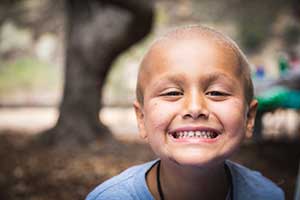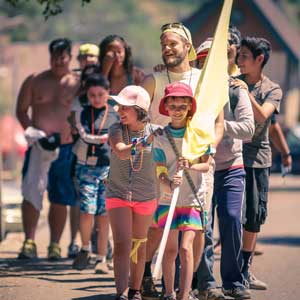A strong foundation
During the six and a half years he battled childhood cancer, Sean Robins was too sick to go to summer camp with his friends.
 But this past summer, 600 youngsters, siblings and adults whose lives have been impacted by their own cancer or that of a family member had the opportunity to enjoy one week, free of charge, at Seany’s Camp Reach for the Sky in southern California ─ thanks to the Seany Foundation, a family philanthropy Sean envisioned and his parents, Mitchell and Amy, established in his memory.
But this past summer, 600 youngsters, siblings and adults whose lives have been impacted by their own cancer or that of a family member had the opportunity to enjoy one week, free of charge, at Seany’s Camp Reach for the Sky in southern California ─ thanks to the Seany Foundation, a family philanthropy Sean envisioned and his parents, Mitchell and Amy, established in his memory.
“It was Sean’s idea to set up a foundation that would help other kids with cancer communicate with each other, and also provide funding for pediatric-cancer research and drug development,” say the Robinses, both University of Michigan alumni, who live in San Diego. “After Sean finally lost his battle with cancer, in November 2006, we launched the Seany Foundation.”
This year marks the 10th anniversary of Sean’s death and a decade of work by the foundation to bring hope, happiness and friendship to other children and families fighting cancer and its devastating effects. “We’re trying to turn something bad into something good,” Mitchell says. “I think we’re making a great impact. We’re convinced Sean would be delighted.”
A family affair
The Robinses have invested $1 million of their own money into the foundation and raised $7 million through charitable contributions from 5,000 active donors and fundraising activities, such as golf tournaments, movie nights, galas and 5K runs. More than 85 percent of the proceeds go to fund programs.Both parents work full-time in professional careers, and neither draws a salary from the foundation. Mitchell, BA/BBA ’77, has operated his own CPA firm, Robins Associates, for 30 years, and Amy nee Green, BS ’78, is a dental hygienist at a private dental practice. Over the years, the Seany Foundation has grown to be a family affair, with Sean’s sister, Emily Brody, 28, and the Robinses’ daughter-in-law, Melanie, 38, coming to work for the philanthropy. Their son, Alexander, 34, is a 2004 U-M graduate with a degree in history.
Despite medical advances in other areas, cancer is the leading cause of death by disease among children and affects youngsters from all walks of life. Often it can recur months or years after an initial diagnosis and intensive treatment, which also can trigger health problems later on. During September ─ which is Childhood Cancer Awareness Month ─ the Children’s Cancer Research Fund estimates 25,000 families around the world will receive news that their child or teenager has cancer, and 6,667 families will lose a child.
Sean’s journey
 For the Robins family, cancer struck Sean, their middle child, with little or no warning in 2000. He was an athletic 16-year-old sophomore and star pitcher and second baseman on the baseball team at Francis Parker School when he was diagnosed with a rare form of bone cancer called Ewing’s sarcoma. During the ensuing years, Sean rode a roller coaster of remission and relapse, as the painful regimen of radiation and chemotherapy appeared at first to work and then ultimately failed to prevent the fatal spread of cancer to his lungs and brain.
For the Robins family, cancer struck Sean, their middle child, with little or no warning in 2000. He was an athletic 16-year-old sophomore and star pitcher and second baseman on the baseball team at Francis Parker School when he was diagnosed with a rare form of bone cancer called Ewing’s sarcoma. During the ensuing years, Sean rode a roller coaster of remission and relapse, as the painful regimen of radiation and chemotherapy appeared at first to work and then ultimately failed to prevent the fatal spread of cancer to his lungs and brain.
After Sean’s death, the Seany Foundation tackled its first project of creating a teen center at Rady Children’s Hospital in San Diego, where he received his cancer treatments. “The hospital had a toy room for children, but no place for teens, so they would hide in their rooms,” Amy explains. “We decided to create a center with computers, big-screen televisions and couches that would give teens their own space.”
Next, the philanthropy set up a fund at the University of California, San Diego to support a clinical research associate and underwrite research projects targeting new treatments and cures for pediatric cancer, particularly sarcomas (solid tumors).
“Only 4 percent of federal government cancer research funding goes to children, and pharmaceutical companies are not developing so-called orphan drugs to treat kids because there’s no financial payback,” Mitchell says. “As a result, the survival rates for pediatric cancer have not improved since the 1960s. Hospitals are still using adult treatments for kids. It is an experiment in what works and what doesn’t.”
Happy campers
 After a university medical official suggested the Robinses devote more time and money to developing programs that improve the quality of life for kids with cancer, Sean’s spirit seemed to intervene.
After a university medical official suggested the Robinses devote more time and money to developing programs that improve the quality of life for kids with cancer, Sean’s spirit seemed to intervene.
“Within three weeks, we got word that the American Cancer Society was closing 54 summer camps it had run for pediatric cancer patients around the country for 32 years,” Mitchell says. “We met with the camp director and the head of ACS in 2013, and they agreed to allow us to take over five camps in southern California. Amy and I always believe that Sean is working behind the scenes.”
Each of the one-week camps caters to a slightly different demographic ─ children, teens, siblings and day campers, age four to 17, and, most recently, adults and their families. To help youngsters on their difficult journey, the program builds a sense of continuity through ongoing email communication and monthly meetings and activities. The camp director, Robert Medina, and half of the 200 volunteer counselors, who come from as far away as Tokyo, are cancer survivors, also with incredible stories. The ACS continues to champion the Seany Foundation’s work, which has extended the camps’ continuous operation to 35 years during which it has hosted 18,000 campers.
Eyes on the prize
Nearly 90 percent of family foundations close within three years due to lack of time and money and a reluctance to keep the memory of the person who passed at the forefront of the organization.
“Some people want to get over a death and move on, but for me, every day is Seany day ─ and I love it,” Mitchell says. “The foundation is a great way of contributing to the community, helping kids with cancer and keeping Sean’s vision alive. I’m definitely using what I learned at the University of Michigan to build and sustain both my CPA business and the philanthropy.”
After its modest beginning as a mom-and-pop organization, the Seany Foundation has evolved over the years, according to Amy. “As the foundation gets bigger and more far reaching, which is what we hope, it will become about a lot more than Sean,” she says. “People who never knew him will get involved. But the things that will never change are how the Seany Foundation started and the fact that Sean is still at the center of it.”




Barbara Nickel - 1979, B.A., 1992 MSW
I knew Sean as a baby and young boy as he played with my children. While he is profoundly missed by all of us here in Michigan, it’s nice to know that the family has turned their grief into a successful foundation based on Sean’s idea.
Reply